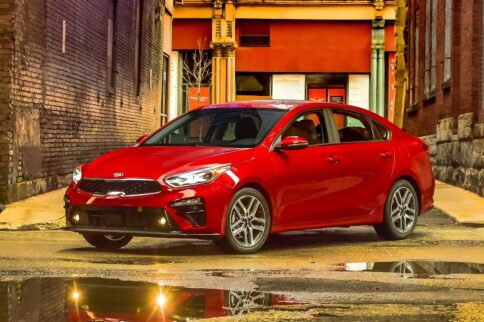By Chris Chase
The compact sedan segment has historically been one of the most popular vehicle categories in the Canadian marketplace. These small four-doors sell well for their combination of affordable prices and good fuel economy.
Market share for small sedans has shrunk as compact crossovers and SUVs have become more popular. Some carmakers have even cut small cars from their lineups so they can focus on their small crossover models. Still, a compact sedan is one of the most affordable ways to get into a practical new vehicle.
Along with the purchase price, maintenance and repair costs are important considerations if you need a set of wheels on the cheap. We contacted the auto industry analysts at Vincentric to find out which compact sedans from the 2020 model year promise to cost the least to maintain over a five-year period.
Vincentric draws on a variety of information sources to calculate maintenance and repair costs. It starts with the car’s maintenance schedule, which you must follow so you don’t void the warranty. Then they add in the cost of fixing unscheduled maintenance items, like worn tires and brakes, the price of engine oil and other fluids, and labour costs, at a rate of $126/hour for the mainstream brands we’re covering in this article.
Finally, Vincentric looks at each vehicle’s warranty coverage and whether it includes any free maintenance.
Here are the results of their research in Canada’s compact sedan class.
- 2020 Kia Forte – $4,818.91
Kia redesigned its Forte sedan into a third generation in 2019 and updated it for 2020 with a new turbocharged engine option. LX and EX trims use a 2.0L four-cylinder (147 hp/132 lb-ft of torque) that comes standard with a six-speed manual in the car’s most basic configuration, while other trims get a continuously variable automatic transmission (which we’ll refer to from this point as a CVT). GT trim uses a 1.6L turbo four-cylinder with 201 hp and 195 lb-ft and a seven-speed automatic.
Fuel consumption for the most common configuration of the 2.0L engine and automatic transmission is rated at 7.9/5.9 L/100 km (city/highway), and the 1.6L turbo model’s estimates are 8.7/6.6 L/100 km.
LX trim ($17,695 with the manual transmission; $19,295 with the automatic) offers basic comfort and convenience, with air conditioning, heated front seats, heated side mirrors, and leather-trimmed steering wheel and shift lever. EX ($20,995) brings attractive extras like wireless smartphone charging and active safety features including blind spot monitoring, collision avoidance and lane keeping assists, and rear cross traffic alert.
Kia Canada’s warranty covers the Forte’s drivetrain and most other components for five years/100,000 km (whichever comes first). For the first year (or 20,000 km), it also covers the cost of replacing wear items like light bulbs, wiper blades, and brake pads.
- 2020 Volkswagen Jetta – $5,192.78
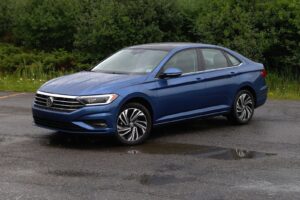
Next on the list is Volkswagen’s Jetta, the most affordable car in the German brand’s Canadian lineup. This car was also redesigned into its current generation in 2019, and was updated for 2020 with a new infotainment display for base models, while the top-end Execline got wireless smartphone charging, a wiper de-icer and heated rear seats.
Comfortline, Highline and Execline trims use a 1.4L turbo four-cylinder engine with 147 hp and 184 lb-ft of torque, with a choice of six-speed manual or eight-speed automatic transmissions. A sporty Jetta GLI uses a 2.0L turbo engine making 228 hp/258 lb-ft. It also comes standard with a six-speed manual transmission, but the option is a seven-speed dual-clutch automatic.
The Jetta’s fuel consumption estimates are 7.8/5.9 L/100 km (city/highway) with the 1.4L engine and automatic transmission, and 7.9/5.9 with the manual. GLI models are rated at 9.3/7.2 L/100 km with the automatic transmission, and 9.6/7.1 with the six-speed manual.
2020 Volkswagen Jetta prices start at $21,245 for a Comfortline model with the manual transmission, or $22,645 with the eight-speed automatic. It comes with heated front seats and side mirrors, auto on/off LED headlights, heated washer nozzles, and air conditioning.
For about $3,000 more, Highline trim adds passive keyless entry, dual-zone automatic A/C, an auto-dimming rearview mirror, rain-sensing wipers and artificial leather upholstery.
The Jetta only offers advanced safety features in an option package in Highline and Execline trims.
Volkswagen’s warranty goes for four years/80,000 km, and during that period, oil changes and various other maintenance procedures are included for free.
- 2020 Hyundai Elantra – $5,329.18
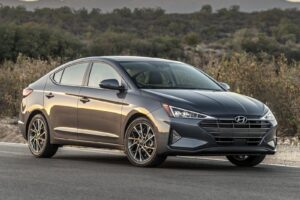
In third place is the 2020 Hyundai Elantra. Redesigned in 2017 and refreshed last year, the Elantra is mechanically similar to the Kia Forte. It uses the same 2.0L engine (147 hp/132 lb-ft) in Essential, Preferred, Luxury and Ultimate trims with six-speed manual or automatic CVT, while Sport versions get Hyundai’s version of the 1.6L turbo engine and its 201 hp/195 lb-ft, with either a stickshift or a seven-speed automatic.
Elantra fuel economy is ranked at 7.8/5.6 L/100 km (city/highway) with the 2.0L motor and CVT, and 9.1/6.3 with the six-speed manual. The Sport and its turbo engine’s estimates are 8.9/7.0 with the automatic, and 10.1/7.6 with a stickshift.
Essential trim starts at $17,149 with a manual transmission, and upgrading to the CVT adds $1,700. For that money, you get heated front seats, air conditioning, heated side mirrors.
Preferred trim includes the automatic transmission for $20,599, and adds alloy wheels, blind spot warning with cross traffic alert, a heated steering wheel, automatic headlights, and a passive function for the keyless entry system. For another roughly $1,500, a Sun and Safety package adds a sunroof, hands-free trunk opening, forward collision avoidance assist, and lane keeping alert and assist. We think that’s where you’ll get the Elantra’s best value for money.
Hyundai Canada warranties the Elantra’s engine and transmission for five years/100,000 km. Other elements of the car are covered for anywhere from one year/20,000 km to three years/36,000 km.
- 2020 Nissan Sentra — $6,309.91
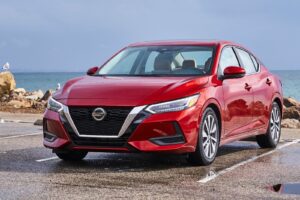
The fourth-place Nissan Sentra is the first compact sedan to break $6,000 in Vincentric’s five-year maintenance and repair cost ranking. The 2020 Sentra is a new design and the model’s eighth generation. Trim levels are S, SV and SR. Sentra S starts with a manual transmission and can be optioned with an automatic CVT that is standard in SV and SR models. All Sentra trims use a 2.0L engine with 149 hp and 146 lb-ft of torque.
Sentra S and SV models with the CVT are rated 8.0/6.0 L/100 km (city/highway), while the SR’s estimates are 8.2/6.2. With the stickshift, the Sentra is ranked 9.4/6.4.
S trim starts at $18,798 (manual) and $20,598 (automatic), a price that notably includes front and rear crash avoidance assist, blind spot monitoring, rear cross traffic alert, and lane departure warning.
You have to move up to SV trim ($21,998) to get heated front seats and side mirrors and the Apple and Android smartphone integration systems. SV also adds dual-zone A/C, passive keyless entry, adaptive cruise control, and remote engine start.
Nissan reserves a heated steering wheel and auto-dimming rearview mirror for the SR package, at $23,998.
Measured on a features-for-money basis, the Sentra is one of the best values in the compact sedan class.
Nissan’s new-vehicle warranty covers the Sentra’s engine and transmission for five years/100,000 km, while the rest of the car is covered for three years/60,000 km.
- 2020 Subaru Impreza
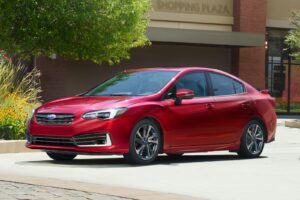
The fifth entry in Vincentric’s compact sedans with the least expensive maintenance and repair costs is the Subaru Impreza.
Subaru completely redesigned the Impreza in 2017 revised its styling for 2020. The Impreza comes in a wide range of trims, but all use a 2.0L engine with 152 hp and 145 lb-ft of torque. A manual transmission is standard in Convenience, Touring and Sport trims. An automatic CVT is optional in those trims and standard in the Sport-Tech package.
The Impreza is the only compact sedan with all-wheel drive, which is included across the range.
Subaru’s fuel consumption estimates for the Impreza are 8.3/6.4 L/100 km (city/highway) with the CVT, and 10.1/7.6 with the six-speed stickshift.
Convenience trim is reasonably well equipped for its sub-$20,000 price, but the $22,695 Touring model is a better value with its automatic A/C, heated front seats, passive keyless entry, a wiper de-icer, auto on/off headlights, and leather-trimmed steering wheel.
However, option an Impreza Convenience with the automatic transmission ($21,995) and you also get Subaru’s well-done EyeSight driver assist package, comprising collision detection and avoidance, adaptive cruise control, and lane departure alert with lane keeping assist.
You can combine those lists of features in a Touring model with the CVT for $24,695. Depending on your priorities, those are the Impreza models we think bring the most value for money.
Subaru’s warranty covers the Impreza’s drivetrain for five years/100,000 km, and looks after the rest of the car for three years/60,000 km.


